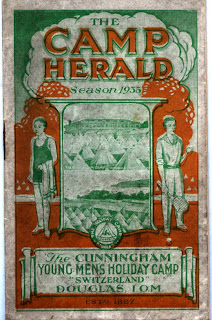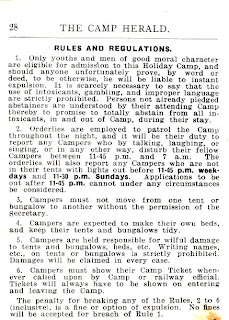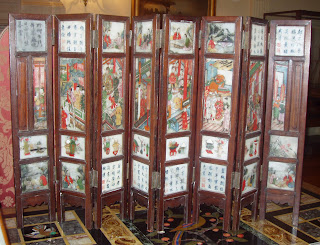Good Morning Campers!

For the last week I have been looking through a variety of small objects to display at Abbey House as part of our newly decorated, seaside themed, penny arcade. These have related to different areas of the British holiday experience - postcards, travelling to the seaside, and the souvenirs you can pick up. As it’s almost the holiday season, I thought it would be a good time to blog about it.
One item that caught my eye and that I have been busy reading is “The Camp Herald” from 1935. This was published by the ‘Cunningham Young Men’s Holiday Camp’, affectionately titled Switzerland, but based in Douglas, Isle of Man. It was first established in 1887, and continued up until 1939. During World War I, it was requisitioned as an internment camp to contain prisoners of war. For World War II, it was requisitioned as a naval training camp. It never managed to recover and re-open as a holiday camp after World War II.
“The Camp Herald” was published yearly to keep campers up to date with the latest goings on, but also to serve as a good piece of marketing. It contains pictures of all the facilities at the camp, alongside testaments from past campers about how much fun they had, and how they will be returning next year with more of their friends.
C.A.E. from Hull, August, 1932 writes:
“I feel it my duty to write and tell you what a wonderful holiday my friend and I had at your Camp. Unfortunately, my friend had only one week, but I soon made fresh pals on my second week. The food is excellent in every way, the bungalows very comfortable, and the service rendered by the Camp staff, not forgetting the Orchestra, is first rate. We both intend coming again next year, and in addition bringing more friends from Hull.”
Looking at the facilities, it may not seem as grand as the Butlin’s or Pontin’s of the mid twentieth century, but it certainly pre-dates them by some way. The ‘campers’ stayed in tents, outdoor chalets, or for the wealthier, there was an indoor bungalow option – with a toilet provided on every floor. They could swim, eat, enjoy a good orchestral concert, play bowls, tennis and golf, or even watch the TT race. The camp offered a valet service to ensure each young man could look his best with nice clean clothes.

It may sound fun and games, but there were rules to the camp – and these were published in the Camp Herald to make sure any ‘would-be’ campers knew what was expected of them. Alcohol was not permitted at any time during the holiday – whether it was on camp or not. Girls were a definite no, especially late at night. And there was a curfew with lights-out – 11.45pm until 7am on weekdays, 11.30pm until 7am on Sundays – with absolutely no chance of an extension to this. Rowdy campers who disobeyed the rules in any way would be swiftly removed.














